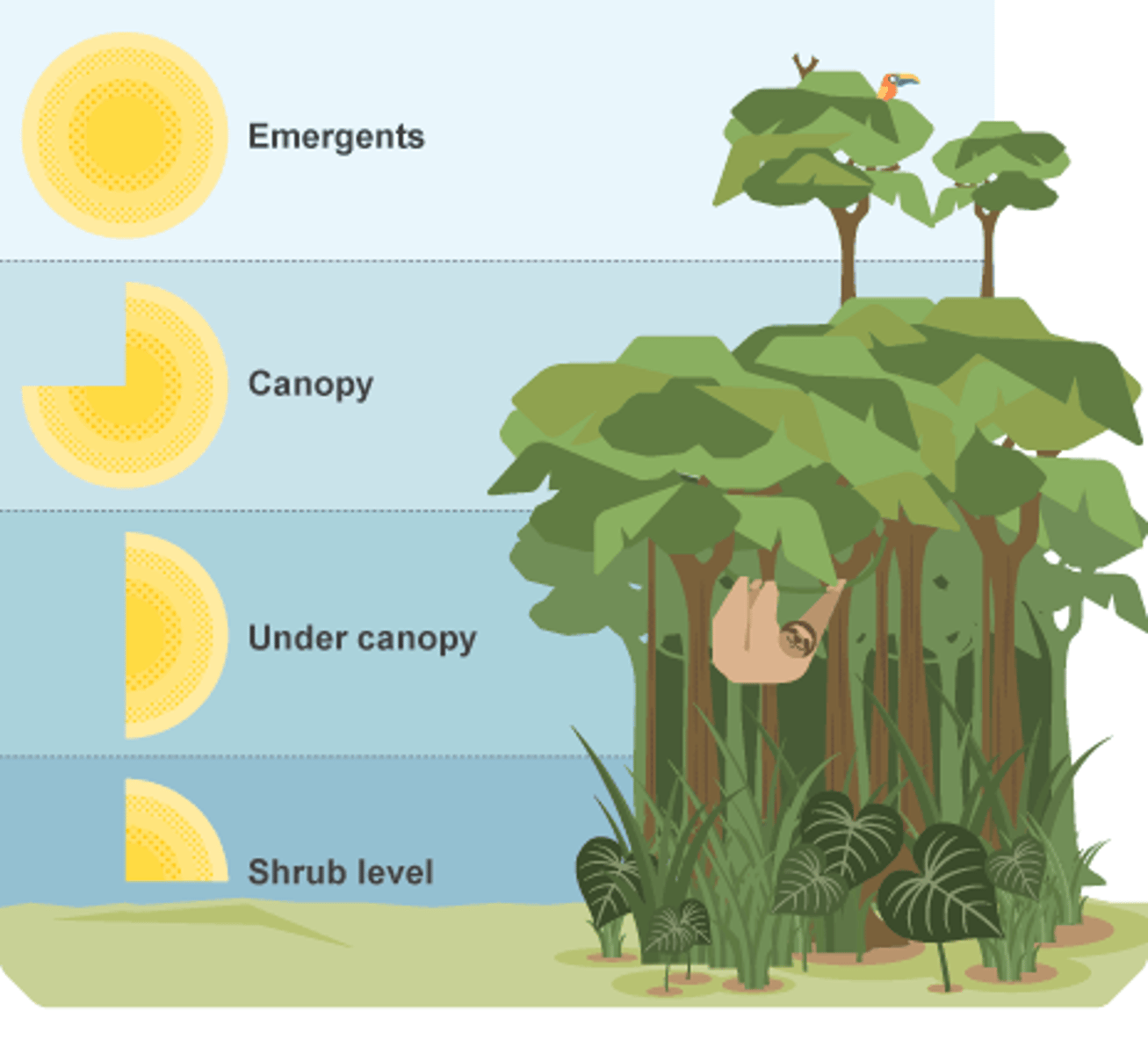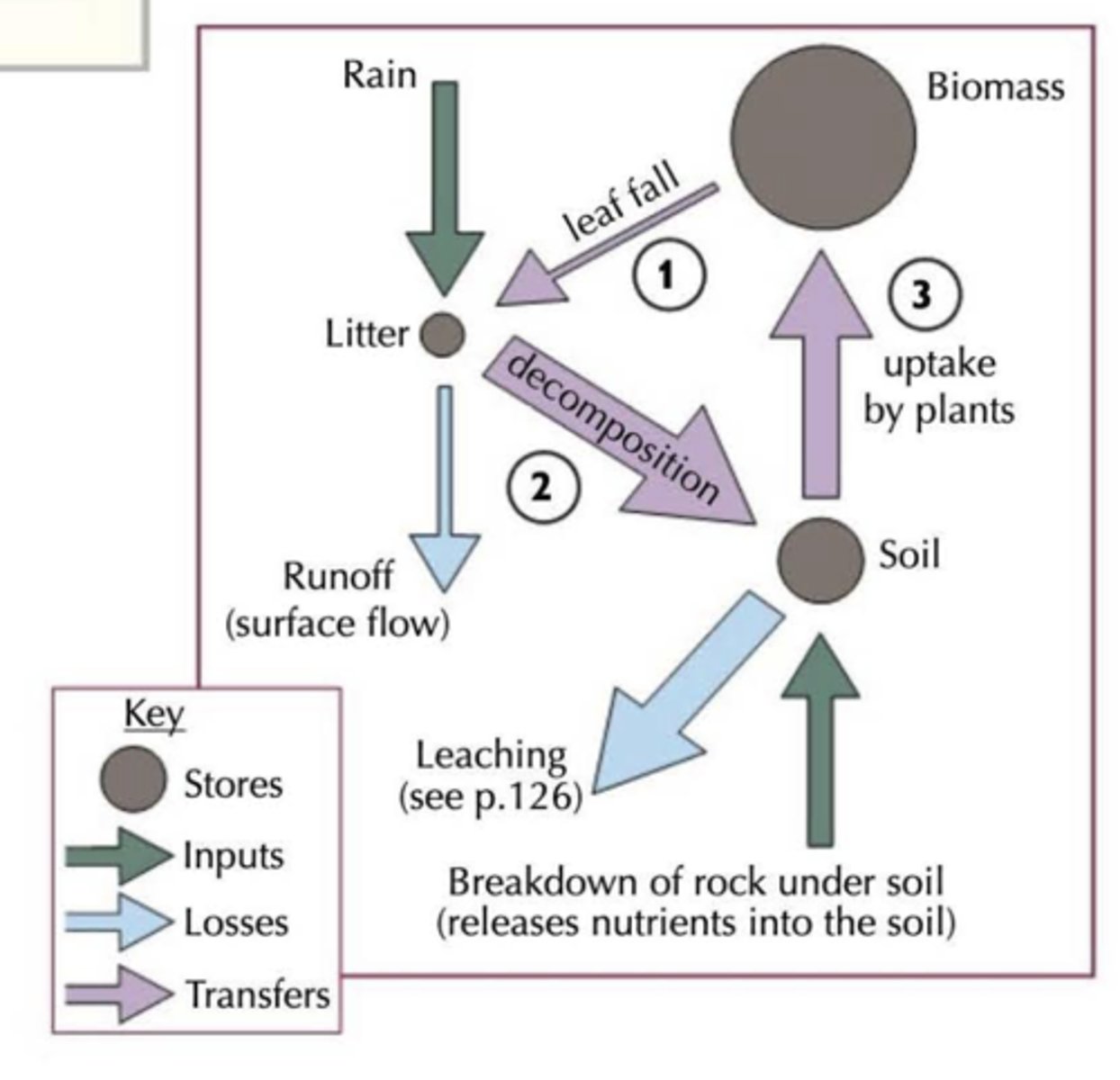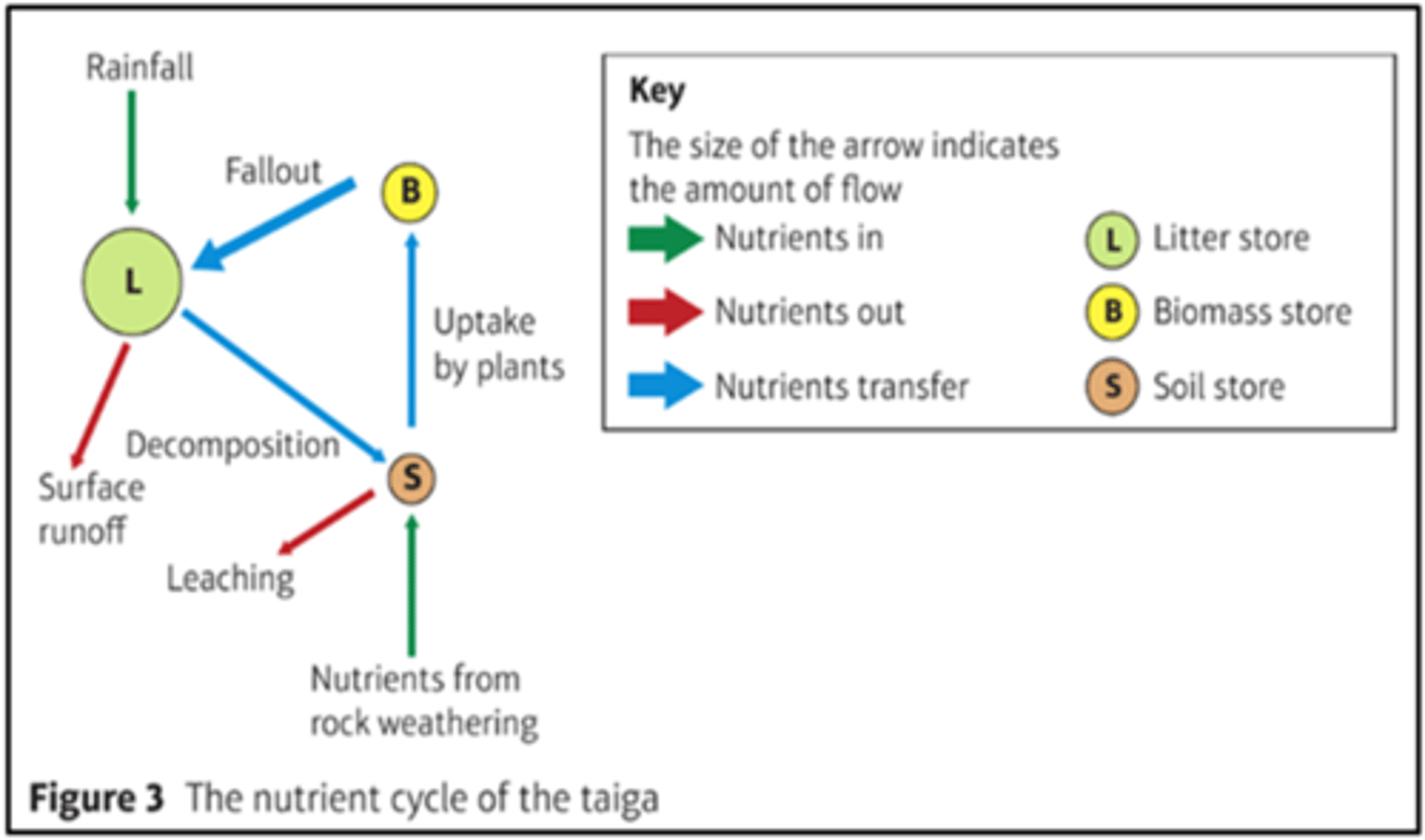Topic 8 - Forests under threat
1/40
Earn XP
Name | Mastery | Learn | Test | Matching | Spaced |
|---|
No study sessions yet.
41 Terms
Biomass
the mass of living biological organisms (plants and animals in an area) - TRF has 3x the biomass of the taiga
Productivity
The rate of biomass generation (how quickly plants grow). TRF has 3x the productivity of the taiga
Foodwebs
The relationship between species in an ecosystem - who eats what. TRF has a more complex food web than the taiga
Why is biodiversity very high in the tropical rainforest?
Due to the optimum conditions (high temps, high rainfall, no seasons). This results in a multi-layered vegetation and a range of habitats therefore a complex food web.
Why is biodiversity relatively low in the taiga?
Due to the harsh conditions (low temps, low precipitation). This results in predominantly coniferous trees with few layers, hostile conditions and limited habitats therefore a less complex food web.
Layers of a tropical rainforest
1. shrub
2. under canopy
3. canopy
4. emergents

How are plants adapted to the tropical rainforest climate?
Waxy leaves with drip tips: these ensure that rainwater runs off the leaf and does not remain which would encourage mould growth or break the leaf.
Buttress roots: large roots above the ground which help to support the very tall trees and help transport water. May also help O2/CO2 exchange by increasing the SA.
Lianas: vines which use the tall trees as support to reach the sunlight.
Epiphytes: plants which grow on branches of trees high in the canopy to seek sunlight - they obtain nutrients from the water and air rather than the soil.
Tin smooth bark on trees: allow water to flow down easily and reach the soil.
How are animals adapted to the tropical rainforest climate?
Sloth:
- algae grow in the fur of the sloth helping to camouflage it
- can't walk but is a good swimmer for when it floods
- huge claws allow them to hang upside down from branches.
Chameleon:
- colour changes to adapt to temperature
- tail increases balance and allows them to hang from trees
- tongue can extend over 20cm with accuracy in order to catch insects
How are plants adapted to the taiga climate?
Needle-shaped leaves: the needle shape and waxy coating reduces water loss (transpiration) during dry periods and frost damage.
Cone shaped: helps the trees shed snow in the winter.
Flexible branches: bend so that they don't break under the weight of the snow and allow the snow to fall off.
Wide, shallow roots: avoid the frozen ground but are wide to support the trees and anchor them in strong winds.
Seeds in cones: the cones surround the seeds to protect them from the intense cold.
How are animals adapted to the taiga climate?
Grizzly bear:
- thick fur which insulates them against extreme cold
- sharp claws which are useful for demolishing burrows of small animals and for fishing salmon
- as winter approaches, they forage and hunt more often so that they can build up body fat, they then hibernate though the extreme winter cold.
Caribou/ reindeer:
- antlers made up dead tissue to withstand cold
- two layers of fur, under layer protects from insect attacks in summer and outer layer grows in winter to protect from extreme cold.
- coat is brown in the summer and white in the winter for camouflage.
Why do tropical rainforests have a very high rate of nutrient cycling?
- Plants grow all year in huge numbers
- dead matter drops to the forest floor and decomposes quickly in the warm, wet conditions
- fast growing plants take up the nutrients very quickly
- the constant precipitation leaches nutrients down through the deep rainforest soil

Why do taigas have a very low rate of nutrient cycling?
- Taiga can only grow in the short summer: 3-5 months
- litter accumulates because decomposition ony happens in the summer
- soils are thin, low in nutrients and acidic
- plants grow very slowly due to short growing season and low nutrient soil.only

Direct threat of tropical rainforests
deforestation
Indirect threat of tropical rainforests
climate change
Human causes of deforestation and effects (TRF)
Commercial hardwood logging: high demand for timber especially rosewood for luxury furniture in China, illegal logging pays well.
Effect: Although rosewood logging is often selective, need for access often involves wider deforestation reducing biodiversity.
Commercial agriculture incl biofuels: increased meat demand, palm oil used in a range of products e.g cosmetics, chocolate.
Effect: Sharp decline in orangutans in Malaysia and Indonesia due to destruction of habits for more plantations.
Subsistence agriculture: people farm to feed families, increase in slash and burn for agricultural land and fuelwood - small scale deforestation and burning of ground.
Effect: accounts for 1/3 of all rainforest destruction (does not allow for recovery)
Demand for electricity (HEP) and mineral resources: mining of minerals e.g iron ore used to create steel for construction (industrialisation has increased demand). HEP used for electricity production to support industrialisation and economic dev.
Effect: Rainforest is totally destroyed to dig open cast mines, roads also built. HEP-land cleared to build dams and then forest is flooded.
Causes of climate change and effects (TRF)
Human activity release greenhouse gases so global temps rise.
Effect: TRF likely to become seasonal with dry season and drought. Species unable to adapt e.g flying fox
Direct threat to taiga
Deforestation
Indirect threat to taiga
Pollution, environmental change
Causes of deforestation (taiga)
Commercial softwood logging - taiga tress produce softwood which are the world's main source of softwood timber, used for construction.
Causes of pollution and effects (taiga)
Commercial exploitation of minerals, fossil fuels and HEP: Large scale oil and gas industries e.g Russia and Canada - internal use and export to support economic growth.
Effect: Can be damaged by side effects of this exploitation e.g oil spills, forest fires. Taiga drainage is poor so oil is not washed away (little leaching) and decay is slow - trees die.
Acid precipitation: When fossil fuels are burnt in industries and power plants, chemicals incl sulphur dioxide and nitrogen oxides are released into the atmosphere. These react with oxygen and water to form acids which fall as acid precipitation.
Effect: Plants are damaged by acid, acid gets into soils, lakes reducing the biodiversity
Causes of environmental change and effects (taiga)
Forest fires: Lightning strokes are a natural cause, also caused by human activity.
Effect: the taiga biome is adapted to forest fires, ash left after a fire is nutrient rich. Forest fires have become so frequent that the young saplings are burnt before they can grow back to replace the old trees.
Pests and disease: the taiga has fungus and mould species that damage conifers' needles trunks and roots. New pests and diseases have spread into the taiga biomes.
Effect: e.g in North America, plagues of spruce-bark beetles have killed large numbers of taiga trees
Global actions which help to protect the rainforest
- CITES
- REDD
CITES
Convention on International Trade in Endangered Species of Wild Fauna and Flora
- countries that sign up to CITES agree to stop exports or imports of endangered animal and plant species
- currently protects 35000 different species
REDD
Reducing Emissions from Deforestation and Forest Degradation
- REDD supports schemes that reduce the rate of deforestation
- uses remote sensing to monitor deforestation rates.
Advantages of CITES
Huge international influence- 181 countries have
signed up to it and co-operate with its policies
Disadvantages of CITES
It is not possible to monitor all countries and so they may not abide by the rules even though they are signed up e.g in 2014 over 1000 rhinos were killed by poachers in South Africa
Advantages of REDD
It is backed by the United Nations- so REDD
projects receive a large amount of funding. A REDD scheme in Brazil is backed by a US$1 billion fund.
Disadvantages of REDD
Unclear what is meant by forest- some palm tree
plantations received funding, even though these
damage rainforest
Reasons why there are falling rates of deforestation
- Forest protection laws, with fines and prosecution for illegal deforestation and financial rewards for protection.
- Growing urban population means less people rely on income from tropical rainforest activities, like agriculture.
Reasons why there are increasing rates of deforestation
- Urban poverty forces people to move to cheaper rural areas where job opportunities are limited, often involving forest degradation (agriculture, logging).
- Newly industrialised countries have high demand for resources from tropical rainforests such as timber, energy sources and tradable resources.
Challenges of sustainable management in TRFs
Economic: Tropical rainforests are located in emerging and developing countries, often the main concern is making money rather than sustainable development
Social: Different communities and groups may want different things from the forest this can lead to conflicts between the groups and may affect sustainable forest management
Alternative sustainable managements of TRFs
Ecotourism: Tropical rainforest ecotourism is becoming more common, as many people want to visit rainforests and take part in activities (bird watching, canoeing, wildlife photography etc.) in a sustainable way.
Ecotourism can also provide income to indigenous populations - by providing jobs such as forest guides, selling local craft to tourists - and fund conservation efforts. For example, The Chalalan ecolodge in Bolivia is ran by an indigenous community and is eco- friendly, attracting 1600 tourists a year.
Sustainable agriculture: helps protect the environment because it reduces the need for farmers to keep clearing new plots of land in the forest. Using better sources of fertiliser and better farming techniques enables farmers to keep using the same plots year after year and also to get better yields from their land.
Challenges of protecting the taiga
- a very fragile ecosystem which takes a long time to recover from damage
- plants grow slowly because of the lack of nutrients and because of cold winters. pollution remains in the ecosystem for decades
- there are very few species in the taiga. a disease that affects one species impacts the whole ecosystem
- taiga animals and plants are highly specialised. they will struggle to adapt to climate change
Challenges of creating and maintaining protected wilderness areas and national parks in the taiga
Migration: Taiga species often migrate long distances. Unless parks and reserves are very large, they cannot protect migrating species once they leave.
Money: Where Taiga has oil and gas, governments face huge pressures to develop them. Exporting oil and gas can lift whole countries out of poverty.
Pollution: The taiga is easily damaged by atmospheric pollution from surrounding areas which can threaten parks. However, if parks are then located far from cities, few tourists will visit them. Money from tourism helps parks fund their conservation.
Challenges of sustainable forestry in the taiga
Sustainable management is expensive and long-term. It is usually only possible for large companies or when international organisations provide funding. In Russia, for example, most of the taiga is leased to hundreds of small-to-medium companies for 25-50 year periods which is less time than it takes new trees to grow. The companies are not interested in sustainable management; they want to maximise profits by clearing as much timber from the taiga as they can within the period of their lease.
Views on managing the taiga - indigenous people
Protect
- Expansion of oil and gas exploration has forced indigenous communities into smaller and smaller areas of land
- Areas for hunting are reduced as are animal populations
- Increased air and water pollution have an impact on health
Views on managing the taiga - environmental and scientific groups
Protect
e.g Greenpeace and IPCC. Argue that oil, gas and HEP exploration are damaging to the ecosystem and are impacting on food webs: such as the decline in woodland caribou populations in Canada
Views on managing the taiga - National Park and Wilderness managers
Protect and Exploit
- Role is to try and balance the needs of different groups
- Challenge due to opposing views, want to protect the ecosystem but also want to create activities for tourists
Views on managing the taiga - Visitors and tourists
Protect and Exploit
- Want to use the areas for recreation and leisure
- won't want to take away from its natural beauty
Views on managing the taiga - HEP companies
In order to maximise profits they will want to remove as much of the ecosystem as is required. This will mean felling and clearance of trees for building the dams and access roads. Large areas will also be flooded for reservoirs. May be conscious of negative public image, however
Views on managing the taiga - Oil, gas and mineral extraction companies
In order to maximise profits they will want to remove as much of the ecosystem as is required. Increased demand for energy has led to exploitation of areas like the Alberta Tar Sands. Leads to water pollution and deforestation.